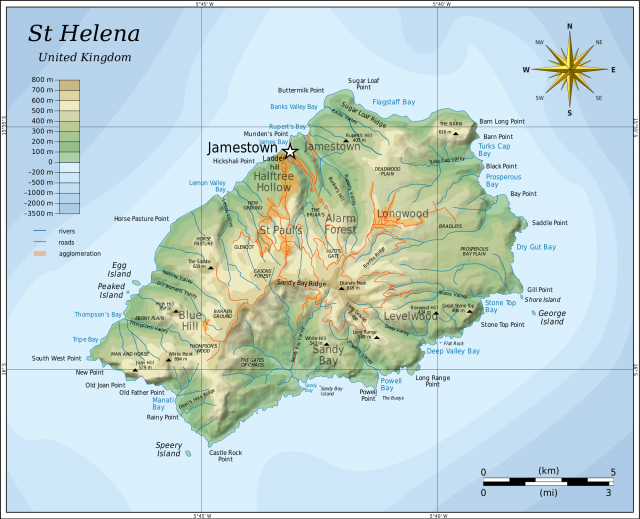St. Helena Island
SAINT HELENA IS AN ISLAND in the South ATLANTIC OCEAN between Africa and South America. The capital is Jamestown. The Crown Colony of Saint Helena is formed by the island of St. Helena, the islands of Tristan da Cunha (more than 1,300 mi or 2,000 km from St. Helena) and ASCENSION (more than 750 mi or 1,200 km from St. Helena). The island has a population of 6,000.
With an area of 47 square mi (122 square km), St. Helena is extremely remote, lying 1,200 mi or 1,931 km off the west coast of Africa and 1,800 mi or 2,896 km from BRAZIL. St. Helena is a volcanic island, although volcanic activity has long since ceased. The last volcanic eruptions occurred about 7 million years ago and since that time the island has been sculpted into its present form by the forces of erosion. The sea has carved the sheer cliffs that ring the island and streams have incised the deep v-shaped valleys.

DISPUTED TERRITORY
St. Helena was discovered by the Portuguese in 1502 and was named after the mother of the Emperor Constantine. The island served as a stopover within the middle of the South Atlantic Ocean; its strategic importance for any seagoing nation was evident. The island, for several centuries, was disputed, especially between the Portuguese, British, Dutch, and several trading companies. In the 18th century, it finally came under the influence of English trading companies (mainly the East India Company), but it took until 1834 for Britain to take it formally under the possession of the Crown.
Despite its enormous importance as a resting and trading place for commercial and military naval activities, St. Helena became famous as a prison for Britain. The best known prisoner of St. Helena was Napoleon Bonaparte of France, who was forced to stay there from 1815 (after Waterloo) until his death on May 5, 1821. On a much larger scale, St. Helena was used as a camp for prisoners of war during the Boer War.
Up to the end of World War II, flax production was a major source of income for the island. Today fishing, coffee, and tourism are the most important factors in the island economy. The importance of shipping to St. Helena decreased in the 19th century with the opening of the Suez Canal, and during the second half of the 20th century, the development of St. Helena was mostly hampered by the lack of an airport, which was under construction in 2004. The Falklands War in 1982 had the most benefit for Ascension Island, but also St. Helena profited from its position on the route between Britain and the Falkland Islands.
The population of St. Helena (known as “Saints”) is a mix of European, African, and Asian descent. Longwood House (the prison of Napoleon Bonaparte) has been, since the times of Queen Victoria and Emperor Napoleon III, legally a part of France within the British Crown Colony. St. Helena has never asked for independence and is still quite dependent on financial contributions from the British taxpayer to maintain a never self-sufficient island economy.